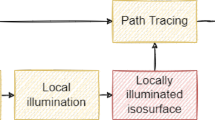Zusammenfassung
Direct Volume Rendering (DVR) techniques are used to visualize surfaces from 3D volume data sets, without computing a 3D geometry. Several surfaces can be classified using a transfer function by assigning optical properties like color and opacity (RGBα) to the voxel data. Finding a good transfer function in order to separate specific structures from the volume data set, is in general a manual and time-consuming procedure, and requires detailed knowledge of the data and the image acquisition technique. In this paper, we present a new Virtual Reality (VR) application based on the HTC Vive headset. Onedimensional transfer functions can be designed in VR while continuously rendering the stereoscopic image pair through massively parallel GPUbased ray casting shader techniques. The usability of the VR application is evaluated.
Access this chapter
Tax calculation will be finalised at checkout
Purchases are for personal use only
Preview
Unable to display preview. Download preview PDF.
Similar content being viewed by others
Literatur
Krüger J,Westermann R. Acceleration techniques for GPU-based volume rendering. Proc IEEE Vis. 2003; p. 38.
Engel K, Hadwiger M, Kniss J, et al. Real-time Volume Graphics. CRC Press; 2006.
Hänel C, Weyers B, Hentschel B, et al. Interactive volume rendering for immersive virtual environments. Proc IEEE 3DVis. 2014 Nov; p. 73–74.
Brooke J, et al. SUS-A quick and dirty usability scale. Usabil Eval Indus. 1996;189(194):4–7.
Albert W, Tullis T. Measuring the user experience: collecting, analyzing, and presenting usability metrics. Newnes; 2013.
Author information
Authors and Affiliations
Corresponding author
Editor information
Editors and Affiliations
Rights and permissions
Copyright information
© 2018 Springer-Verlag GmbH Deutschland
About this paper
Cite this paper
Scholl, I., Suder, S., Schiffer, S. (2018). Direct Volume Rendering in Virtual Reality. In: Maier, A., Deserno, T., Handels, H., Maier-Hein, K., Palm, C., Tolxdorff, T. (eds) Bildverarbeitung für die Medizin 2018. Informatik aktuell. Springer Vieweg, Berlin, Heidelberg. https://doi.org/10.1007/978-3-662-56537-7_79
Download citation
DOI: https://doi.org/10.1007/978-3-662-56537-7_79
Published:
Publisher Name: Springer Vieweg, Berlin, Heidelberg
Print ISBN: 978-3-662-56536-0
Online ISBN: 978-3-662-56537-7
eBook Packages: Computer Science and Engineering (German Language)




